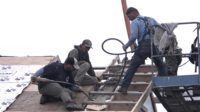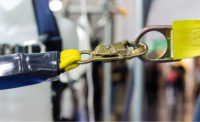Walter Visage was in a car down at street level outside the Pittsburgh manufacturing building used by W.W. Paterson, a manufacturer of towing and lifting equipment, when he spotted someone on the roof. It was 8 a.m. on Jan. 9, 2020, and the person on the roof appeared not to have any fall-arrest harness or perimeter barrier in place.
Visage, a compliance officer for the US Occupational Safety & Health Administration, pulled over and started to take pictures.
Other workers at ground level were preparing to use a crane. Then Visage spotted another worker about 125 ft away on another part of the roof.
W.W. Paterson had hired CentiMark, a large Canonsburg, Pa.-based roofing contractor, to replace portions of four interconnected roofs at 870 Riversea Road in Pittsburgh. Parts of the roof were steeply pitched; others were low-slope.
Visage found the company’s practices wanting and in violation of OSHA fall protection rules. After a follow-up inspection two weeks later, OSHA issued it a two-item citation, alleging two serious violations, one a repeat violation.
The issue being contested by CentiMark is whether it was already in the process of doing roofing work, when all the OSHA fall-protection rules would have to be observed, or preparing for roofing work including setting up safety systems.
What is being contested is whether the contractor was already in the process of doing roofing work, when all the OSHA fall-protection rules would have to be observed, or, as CentiMark says, preparing for roofing work and inspecting the roof sections including setting up safety systems.
An $800-million-per year, family-owned company, CentiMark appealed the violations all the way to the OSHA Review Commission, an entity that handles appeal decisions by regional administrative law judges.
The commission's Chief Administrative Law Judge, Covette Rooney, held a hearing on the matter by video conference in April, and an extension was granted in the case for both parties. In June, both sides filed post-hearing briefs and the next month both filed reply briefs.
As a result, Rooney in a late September order, proposed to vacate Citation 1, Item 1, for the failure to provide perimeter protection on steep roofs with guardrails, nets or fall arrest harnesses, and also affirmed Item 2, as a repeat violation, for failure to provide fall protection on low-slope roofs.
The order, not yet final, is being reviewed by the full commission.
CentiMark officials feel they have been wrongly cited. Brian Raymore, CentiMark vice president for safety and risk, said the company's "crane had just gotten there. One of the guys went on the roof to see where there was a safe place to signal the crane from. For the second citation, we were actually putting the warning lines on the roof, and they cited us for that.”
Rooney ruled in the company’s favor on that aspect of the original penalties, in Raymore's view, because having a foreman wear a fall-arrest harness while setting up the safety lines himself would have required the company to install a metal plate-anchor on the roof—with 16 screws that can only be set in with a compressor.
"It’s called an inspector’s exemption,” Raymore said.
But Rooney's description of matters in his proposed final order includes numerous details intended to show that work was beyond an initial preparatory phase.
For example, Rooney stated that CentiMark staff had already engaged in the pre-job inspection and had been on site for well over an hour when Compliance Officer Visage drove by.
Also, Rooney noted that CentiMark employees were busy at work and being paid at least from the time of their arrival, and that those employees had placed trucks close to roofs, loaded materials onto the crane bed and completed a “Fall Protection/Safety Work Plan.” Moreover, the crane boom was elevated and an employee was directing traffic near the worksite.
"As the [compliance officer] explained," Rooney wrote in the proposed final order, "none of the people present were there for leisure purposes and had already completed various tasks that were not tangential to the roofing work but required for the roofing work to be completed."
What was happening on the roof, however, was a little different.
Foreman Greg Kent had been on the steep-pitched roof section, placing cones for a planned flag line that would demarcate what he considered a safe work area. A second foreman, Stanley Harmon, was on a low-slope roof, assessing locations where he could signal the crane when hoisting materials.
It’s not clear when the commission will issue a final order as it accepts briefs from CentiMark and OSHA attorneys.
CentiMark Fights Citation on Principle
CentiMark might have easily called the whole matter off early, by agreeing to some violation and paying a fine. But the fact that the firm is fighting the citations gives some sense of how strongly it disagrees with OSHA's allegations.
“[The foreman who was cited] was up there clearly to inspect,” Raymore said. “It cost us a lot of money, but we felt strongly that we were in the right.”
From the contractor’s perspective, the whole ordeal makes no sense,
“We think we were unfairly cited, Raymore said. "We were completely compliant. That’s why we contested it.”






Post a comment to this article
Report Abusive Comment